IMAGO System Design
IMAGO is a Costa Rican company dedicated to event production and equipment rental for large-scale productions. To improve inventory management and optimize communication between key areas such as warehouse, purchasing, and sales, the design of an integrated inventory system was proposed. This system aimed to centralize control over available equipment, streamline distribution logistics, and ensure operational efficiency, adapting to the dynamic needs of the company and its events.
Moodboard
The project began with a research and conceptualization phase, during which a moodboard was created with visual and functional references.
This process was crucial for gaining a clear understanding of the client's needs and expectations. By gathering graphic examples and operational workflows, we established a solid foundation for designing the inventory system, aligning the proposal with the company’s identity and specific requirements.
User Flow
The flowchart is one of the most important parts of my design process, as it allows me to clearly and visually understand the user's journey within the system. This diagram not only helps identify key steps and decision points, but it is also crucial for designing a more seamless and 'manageable' user experience. By mapping the interaction flow, we can optimize each stage and ensure that navigation is intuitive, efficient, and aligned with the user's needs.
Low Fidelity Wireframes
In this phase I developed the first approach to some visual prototypes that mapped out the user journey and the interface’s final look. This approach allowed us to practically test which elements worked well and which needed adjustments, making it easier to gather precise feedback from the client. This process helped refine the system’s structure to optimize user experience and enhance our understanding of the overall functionality.
Design System
High Fidelity Wireframes
The final stage of the process is the high-fidelity wireframes, where the system reaches its most realistic version. At this stage, clients can experience a close approximation of the final product, and developers can begin integrating elements from the Design System, using the wireframes as a customized “template” for implementation. This is the project’s finished deliverable, ready for the development phase.















